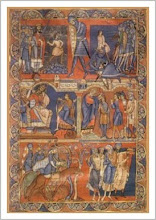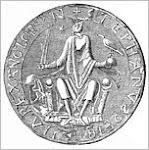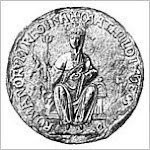• Invasion and Conquest
Harold may have been Edward the Confessor's brother in law but Duke William of Normandy was Edward's cousin and therefore with some claim to the throne. William also believed that a pact had been made, albeit a forced one from Harold's point of view, in 1064 in which William would become king of England and Harold would retain all of Wessex linked to the crown by marriage with his daughter. This story as well as the subsequent Battle of Hastings is told, from the Norman perspective of course, in the Bayeux Tapestry. The tapestry is an eleventh century embroidery most likely commissioned by Bishop Odo, Duke William's half brother, for his cathedral.
William prepared to seize what he thought was rightfully his and Harold awaited his arrival with confidence. However, another invasion was being planned by Canute's successors in Norway. Harold's half brother Tostig had joined in a pact with King Harold Hardrada and, after gathering a large fleet and army, they sailed toward the northeast coast of England. This left Harold facing two invasions, one from the north and one from the south. When news reached Harold that Hardrada, Tostig, and their army were encamped in York he marched north to confront them and arrived within five days. On 25th September Harold's army met Tostig and Hardrada's forces in battle at Stamford Bridge and inflicted a resounding defeat on their army. Hardrada was killed in the first skirmish and Tostig took command. Harold offered
Tostig peace but he refused it and at the battle's end he too lay dead. With this victorious battle barely over Harold received the news that William had landed at Pevensey Bay on 28th September. William had secured the sanction of Pope Alexander II for a Norman invasion. The Norman conquest of England had begun.
Harold marched his army south and prepared to meet William's forces. At dawn on 14th October 1066 William set out to attack Harold's army and the Battle of Hastings began. By nightfall the last line of Saxon troops were broken by a feigned retreat of the mounted Normans, and Harold and his brothers Gyrth and Leofwine had been killed. A scene from the Tapestry depicts a Saxon, thought to be King Harold, pierced by an arrow through the eye.
William waited for two weeks for a formal surrender of the English throne. However, the Witan proclaimed the youthful fifteen year old Edgar Aetheling king instead. William marched to London but his initial advance was beaten back at London Bridge. He then decided on a new tactic which was to march westward and storm London from the northwest. He crossed the Thames at Wallingford, and in early December forced the surrender of Archbishop Stigand who was one of Edgar's main supporters. William pressed on relentlessly and reached Berkhamsted a few days later. It was here that Edgar Aetheling relinquished the crown and the Saxon noblemen surrendered. William was formally crowned on Christmas Day 1066 in Westminster Abbey by Archbishop Aldred.
• The Battle of Hastings:
An account of the battle by William of Malmesbury: The Battle of Hastings, 1066
• The Battle of Stamford Bridge:
An account of the battle from Norwegian sources - Theodricus Monachus: Battle of Stamford Bridge
• William, Duke of Normandy:
By William of Newburgh - Book 1: William, Duke of Normandy
Subscribe to:
Post Comments (Atom)








No comments:
Post a Comment